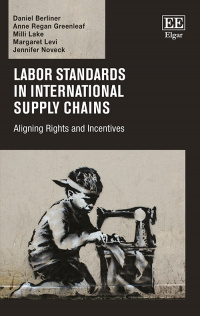精装
Labor Standards in International Supply Chains
一致的权利和激励措施
9781783470358 Edward Elgar Publishing
国际供应连锁店的劳动标准检查了过去三十年来工作条件的发展。作者分析了利益相关者和机制,这些机制在包括服装,鞋类和电子产品在内的部门中创造了改善世界各地劳工权利的挑战和机会。来自中国,洪都拉斯,孟加拉国和美国的扩展例子以及新的定量证据说明了关键群体内部和包括品牌,供应商,政府,工人和消费者在内的关键群体内部的复杂动态。
更多信息
Critical Acclaim
内容
更多信息
作者研究了过去三十年来全球供应链中劳动标准方面的发展,分析了为改善工作条件带来挑战和机会的因素。它们说明了关键群体内部和包括品牌,供应商,政府,工人和消费者的复杂动态。
作者使用中国,洪都拉斯,孟加拉国和美国的扩展例子,以及新的定量证据,分析利益相关者和机制,这些机制创造或阻碍了改善劳动权利的机会。他们评估了参与者及其利益的关键簇,以便全面绘制组成全球供应链的复杂互动和关系。原始数据和分析,包括四个深入的案例研究,介绍了对不断变化的行业劳动标准的系统评估,包括服装,鞋类和电子产品。
对新兴的研究领域的这一令人兴奋的新贡献将使劳工权利和人权学者以及对劳动和工作条件感兴趣的学生受益。它还为希望影响工作条件变化的政治科学家,非政府组织和从业人员提供关键信息,并在全球经济中了解更多有关主要参与者的信息。
作者使用中国,洪都拉斯,孟加拉国和美国的扩展例子,以及新的定量证据,分析利益相关者和机制,这些机制创造或阻碍了改善劳动权利的机会。他们评估了参与者及其利益的关键簇,以便全面绘制组成全球供应链的复杂互动和关系。原始数据和分析,包括四个深入的案例研究,介绍了对不断变化的行业劳动标准的系统评估,包括服装,鞋类和电子产品。
对新兴的研究领域的这一令人兴奋的新贡献将使劳工权利和人权学者以及对劳动和工作条件感兴趣的学生受益。它还为希望影响工作条件变化的政治科学家,非政府组织和从业人员提供关键信息,并在全球经济中了解更多有关主要参与者的信息。
Critical Acclaim
``这本书构成了对不断发展且越来越重要的学术领域的宝贵贡献,并将被证明对有兴趣了解更多有助于全球供应链中工作条件的因素的人有用或从业者。
– Journal of Industrial Relations
‘Exhibiting a refreshing disregard for industry-approved narratives about labor rights, in which progress flows from the spigot of an espresso machine at a “corporate social responsibility” seminar, the authors focus with precision on the factors that actually determine labor rights outcomes: the economic interests of global brands, and their suppliers, and how these are mediated by governments’ regulatory choices and by the efforts of workers and allied groups to make brands pay a reputational price for the labor abuses they help create. Readers will better understand why early 20th century working conditions still exist in the 21st – and what might be done about it.’
– Scott Nova, Executive Director, Worker Rights Consortium
– Journal of Industrial Relations
‘Exhibiting a refreshing disregard for industry-approved narratives about labor rights, in which progress flows from the spigot of an espresso machine at a “corporate social responsibility” seminar, the authors focus with precision on the factors that actually determine labor rights outcomes: the economic interests of global brands, and their suppliers, and how these are mediated by governments’ regulatory choices and by the efforts of workers and allied groups to make brands pay a reputational price for the labor abuses they help create. Readers will better understand why early 20th century working conditions still exist in the 21st – and what might be done about it.’
– Scott Nova, Executive Director, Worker Rights Consortium
内容
内容: 1. Introduction 2. The Worlds Brands Create 3. Aligning Interests Across Global Supply Chains: An Analytic Framework 4. The International Framework for Labour Standards 5. Labor Standards Around the World: A Quantitative Examination 6. The United States in the Struggle for Labor Standards 7. Apparel Production in Honduras: A Case of Cross-cluster Alignment 8. Apparel Production in Bangladesh: Opportunity Amidst Tragedy? 9. Labor Resistance and Local Government – Supplier Collusion in Post-1986 China 10. Conclusion Index





